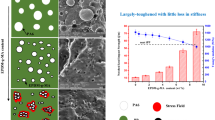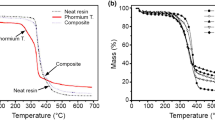Abstract
In order to investigate hydrolysis behavior and associated variation in mechanical properties of bioresorbable plastic composites, β-tricalcium phosphate (β-TCP)/poly(l-lactide) (PLLA), the immersion tests into phosphate buffered solution (PBS) with different pH were conducted. After the immersion tests, tensile, bending and compressive tests were conducted on the specimen. The significant decrease in the mechanical properties of the specimens with 5.0 wt% β-TCP contents were not observed in the pH = 7.4 immersion tests, whereas significant decrease were observed for the specimen with 9.5 and 14.0 wt% contents after 24 weeks. In the pH = 6.4 immersion tests, the degradation was accelerated. From the fracture surface observation, debondings between β-TCP and PLLA grew into the void shape in the ductile fracture surface before immersion tests, whereas the voids were observed in the brittle fracture surface after immersion tests. This is due to the bioresorption of β-TCP particles and/or β-TCP/PLLA interface. In order to discuss the degradation of mechanical properties, tensile modulus degradation was analyzed based on the micromechanics supposing the damaged particles as voids. Degradation tendency predicted was in good agreement with experimental results. These results suggested that the degradation in modulus was attributed to lower load capacity of β-TCP particles and lower load transfer to β-TCP particles due to the hydrolysis of the β-TCP particles and the interface between β-TCP and PLLA.










Similar content being viewed by others
References
C. Migiaresi, L. Fambri, D. Cohn, J. Biomater. Sci. Polym. Ed. 5, 591–606 (1994). doi:10.1163/156856294X00220
H. Pistner, H. Stallforth, R. Gutwald, J. Mühling, J. Reuther, C. Michel, Biomaterials 15, 439–450 (1994). doi:10.1016/0142-9612(94)90223-2
H. Pistner, D.R. Bendix, J. Mühling, J.F. Reuther, Biomaterials 14, 291–298 (1993). doi:10.1016/0142-9612(93)90121-H
E.A.R. Duek, C.A.C. Zavaglia, W.D. Belangero, Polymer (Guildf) 40, 6465–6473 (1999). doi:10.1016/S0032-3861(98)00846-5
C.C.P.M. Verheyen, J.R. de Wijn, C.A. van Blitterswijk, K. de Groot, J. Biomed. Mater. Res. 26, 1277–1296 (1992). doi:10.1002/jbm.820261003
C.C.P.M. Verheyen, C.P.A.T. Klein, J.M.A. de Blieckhogervorst, J.G.C. Wolke, C.A. van Blitterswijn, K. de Groot, J. Mater. Sci. Mater. Med. 4, 58–65 (1993). doi:10.1007/BF00122979
Y. Shikinami, M. Okuno, Biomaterials 20, 859–877 (1999). doi:10.1016/S0142-9612(98)00241-5
Y. Shikinami, M. Okuno, Biomaterials 22, 3197–3211 (2001). doi:10.1016/S0142-9612(01)00072-2
T. Furukawa, Y. Matsusue, T. Yasunaga, Y. Shikinami, M. Okuno, T. Nakamura, Biomaterials 21, 889–898 (2000). doi:10.1016/S0142-9612(99)00232-X
S. Hasegawa, S. Ishii, J. Tamura, T. Furukawa, M. Neo, T. Matsusue et al., Biomaterials 27, 1327–1332 (2006). doi:10.1016/j.biomaterials.2005.09.003
M. Kikuchi, Y. Suestugu, J. Tanaka, M. Akao, J. Mater. Sci. Mater. Med. 8, 361–364 (1997). doi:10.1023/A:1018580816388
A.A. Ignatius, P. Augat, L.E. Claes, J. Biomater. Sci. Polym. Ed. 12, 185–194 (2001). doi:10.1163/156856201750180915
S. Kobayashi, K. Sakamoto, JSME Int. J. Ser. A 49, 314–320 (2006). doi:10.1299/jsmea.49.314
Author information
Authors and Affiliations
Corresponding author
Rights and permissions
About this article
Cite this article
Kobayashi, S., Sakamoto, K. Effect of hydrolysis on mechanical properties of tricalcium phosphate/poly-l-lactide composites. J Mater Sci: Mater Med 20, 379–386 (2009). https://doi.org/10.1007/s10856-008-3583-2
Received:
Accepted:
Published:
Issue Date:
DOI: https://doi.org/10.1007/s10856-008-3583-2




